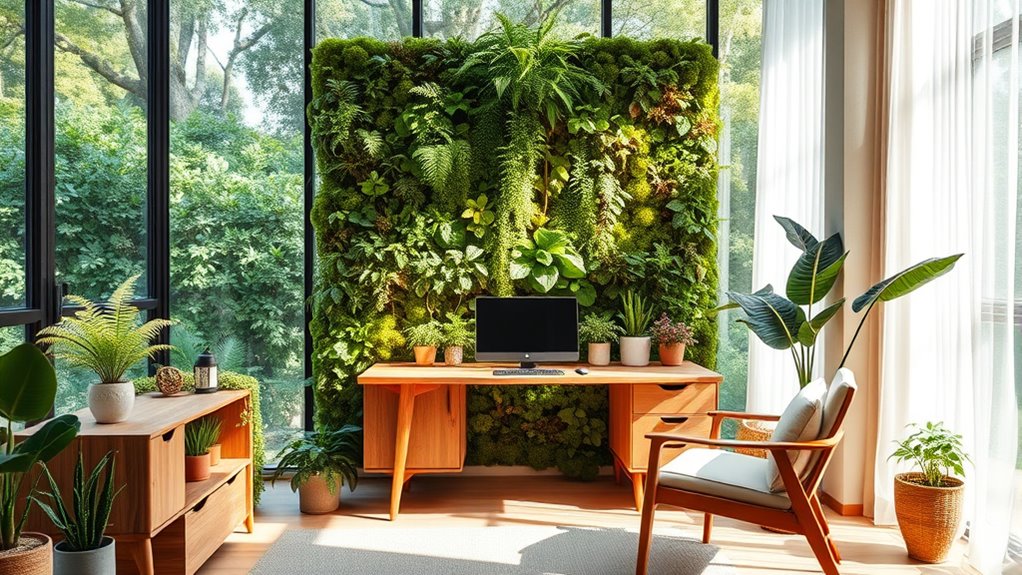To create a biophilic home office, incorporate indoor plants and natural materials to boost air quality and warmth. Maximize natural light and airflow by positioning your workspace near windows and using adjustable treatments. Include views of outdoor greenery and add water features for tranquility. Use earth tones and textures like wood and stone to foster relaxation. Keep your space clutter-free to enhance focus. Continue exploring these principles to transform your workspace into a calming, productive oasis.
Key Takeaways
- Incorporate indoor plants and greenery to enhance aesthetics, air quality, and foster a natural visual connection.
- Maximize natural light and airflow through strategic window placement, treatments, and operable windows.
- Use natural materials, textures, and earth tones to create a calming, biophilic environment that reflects nature.
- Include views of outdoor spaces and water features to promote relaxation and reduce stress.
- Maintain an organized, clutter-free space to support focus, well-being, and a sense of harmony.
Incorporating Indoor Plants and Greenery
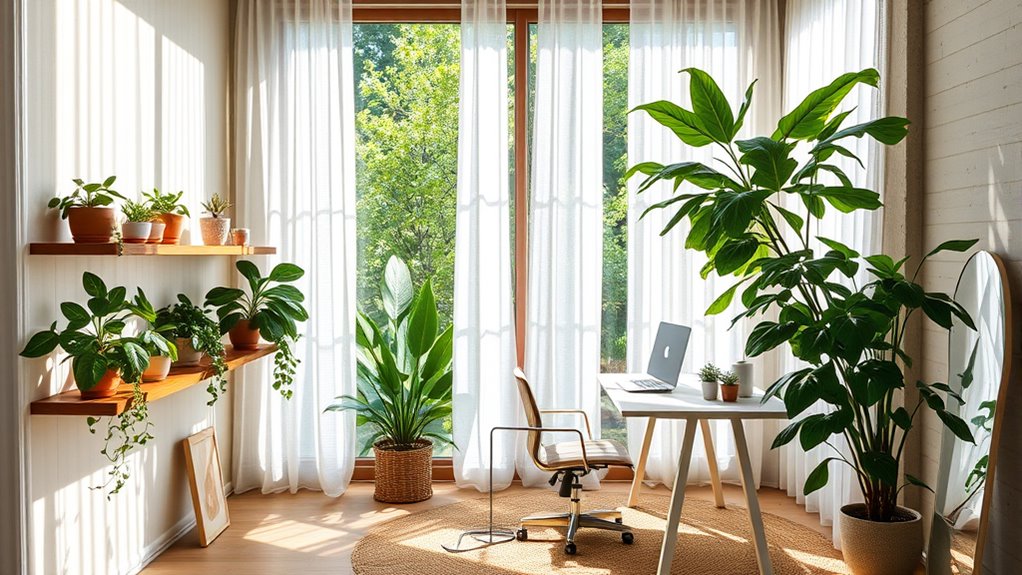
Including indoor plants and greenery is one of the simplest ways to bring biophilic design into your space. Adding air purifying plants not only enhances aesthetics but also improves indoor air quality. Place greenery accents around your home office to create a calming environment that connects you with nature. Choose low-maintenance plants like snake plants or pothos to guarantee they thrive with minimal effort. Strategically positioning these plants near your workspace can boost your mood and productivity. Greenery acts as a natural visual break, reducing stress and increasing focus. Incorporating different textures and heights to add visual interest and a sense of organic diversity. With thoughtful placement, indoor plants become a crucial element for creating a healthier, more inviting workspace. Integrating natural elements into your design can significantly enhance the overall ambiance and promote well-being.
Maximizing Natural Light and Ventilation
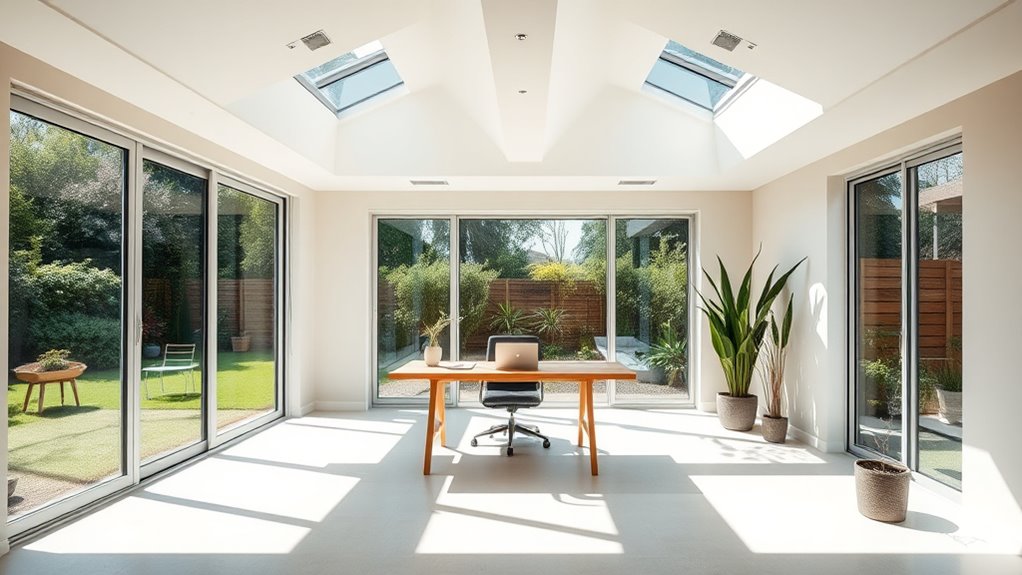
Maximizing natural light and ventilation is essential for creating a healthier, more energizing space. To do this, choose window treatments that control glare without blocking daylight, like sheer curtains or adjustable blinds. Structural shading, such as overhangs or pergolas, helps reduce heat gain while allowing sunlight to filter in. Keep windows unobstructed to encourage airflow and improve indoor air quality. Position your desk near windows to benefit from natural light, which boosts mood and productivity. Use operable windows to facilitate fresh air exchange, reducing reliance on artificial cooling and heating. Additionally, incorporating natural ventilation strategies can significantly enhance airflow and air quality. Properly balancing light and ventilation creates a dynamic environment that supports well-being and focus, making your home office a true sanctuary for work and relaxation.
Using Natural Materials and Textures
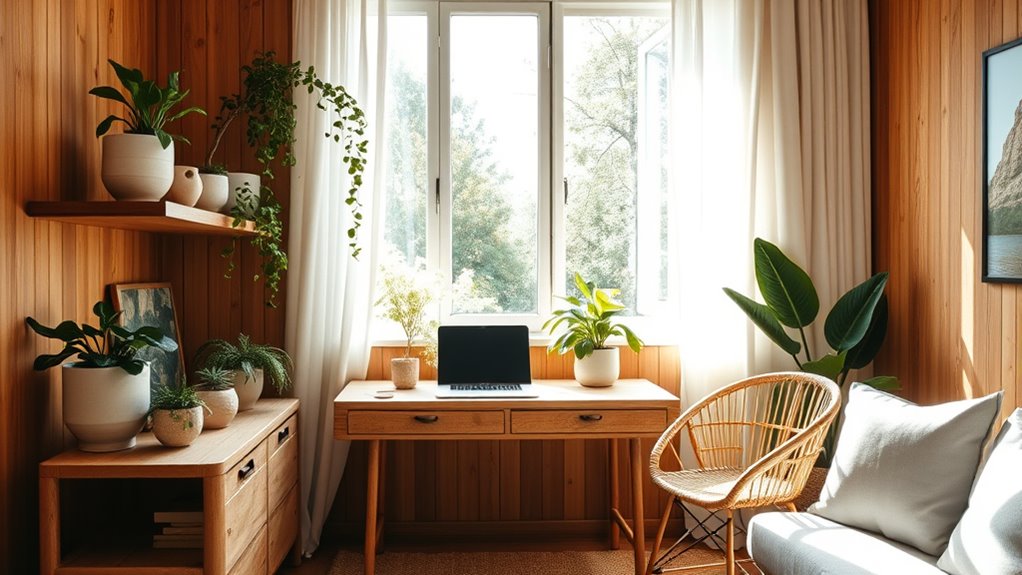
You can create a more inviting space by incorporating organic textures and natural finishes that connect indoors with nature. Choosing sustainable materials not only benefits the environment but also adds authenticity to your design. Highlighting these natural elements helps foster a calming, biophilic atmosphere in your environment. For a personalized touch, consider selecting dog names that reflect the natural or traditional themes present in your decor.
Incorporate Organic Textures
To create a more natural and calming environment, incorporating organic textures through natural materials is essential. You can introduce textured fabrics like linen, burlap, or wool to add tactile warmth and visual interest to your space. These materials evoke the softness of nature while providing comfort during long work hours. Additionally, natural stone surfaces such as slate, granite, or marble bring earthy, rugged textures that connect you to the outdoors. Use stone on countertops, accent walls, or decorative elements to foster a grounded, serene atmosphere. By blending textured fabrics with natural stone surfaces, you create a multi-sensory experience that promotes relaxation and focus. These organic textures serve as tangible reminders of nature, enhancing your home office’s biophilic appeal. Incorporating attention into your design process can also help you select the most suitable textures that foster concentration and well-being.
Use Sustainable Materials
Building on the appeal of organic textures, choosing sustainable materials guarantees your space remains environmentally friendly and healthy. Reclaimed wood adds warmth and character while reducing waste and conserving resources. It’s durable, stylish, and supports eco-friendly practices. When selecting paints, opt for biodegradable options that emit fewer toxins, ensuring better air quality in your home office. These paints break down naturally, minimizing environmental impact and creating a healthier workspace. Using sustainable materials not only supports eco-conscious living but also enhances the natural ambiance of your space. Incorporating infidelity cases and other social issues into design considerations can foster a more mindful and responsible environment. By integrating reclaimed wood and biodegradable paint, you create an environment that’s both aesthetically pleasing and aligned with biophilic principles. This intentional material choice fosters a connection to nature while reducing your ecological footprint.
Highlight Natural Finishes
Highlighting natural finishes involves emphasizing authentic textures and materials that evoke a sense of connection to the outdoors. Incorporate natural wood for furniture or accents to add warmth and organic appeal. Its grains and imperfections bring a tactile quality that makes your space feel grounded and inviting. Stone finishes, whether on walls, flooring, or decorative elements, add durability and a raw, earthy feel. Using stone creates visual interest while reinforcing a natural aesthetic. Combining these textures can create a harmonious environment that fosters calm and focus. Keep finishes simple and true to their natural state to maximize their calming effect. By highlighting natural wood and stone finishes, you bring the outdoors inside, enhancing the biophilic quality of your home office. Additionally, selecting finishes with sustainable sourcing ensures that your design supports environmental responsibility while maintaining a natural look.
Creating Views of Nature and Outdoor Spaces
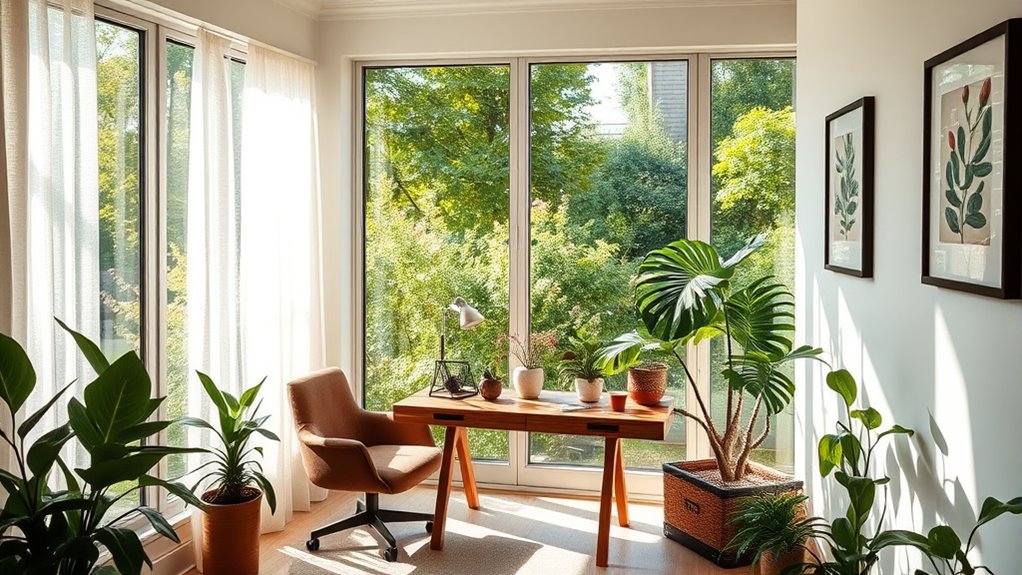
Have you ever noticed how a view of nature can instantly boost your mood and reduce stress? Enhancing your home office with outdoor spaces and natural vistas creates a calming environment. Installing bird-friendly windows allows you to enjoy birdwatching without harming wildlife, adding a lively touch to your view. Consider adding outdoor seating areas where you can step outside, breathe fresh air, and reconnect with nature. Strategically positioning your workspace near windows with natural views maximizes daylight and visual connection to the outdoors. Here’s a quick overview:
| Feature | Benefit | Implementation |
|---|---|---|
| Bird-friendly windows | Supports local wildlife | Use specialized glass |
| Outdoor seating areas | Promotes relaxation | Create patios or decks |
| Window placement | Enhances natural light | Optimize for views |
| Native plant landscaping | Attracts local birds and insects | Incorporate native species |
| View preservation | Maintains visual connection | Keep sightlines clear |
Creating these outdoor connections nurtures your well-being and productivity. Incorporating these design principles can also support soundscapes that promote tranquility, further enhancing your home office environment.
Integrating Water Elements for Calmness
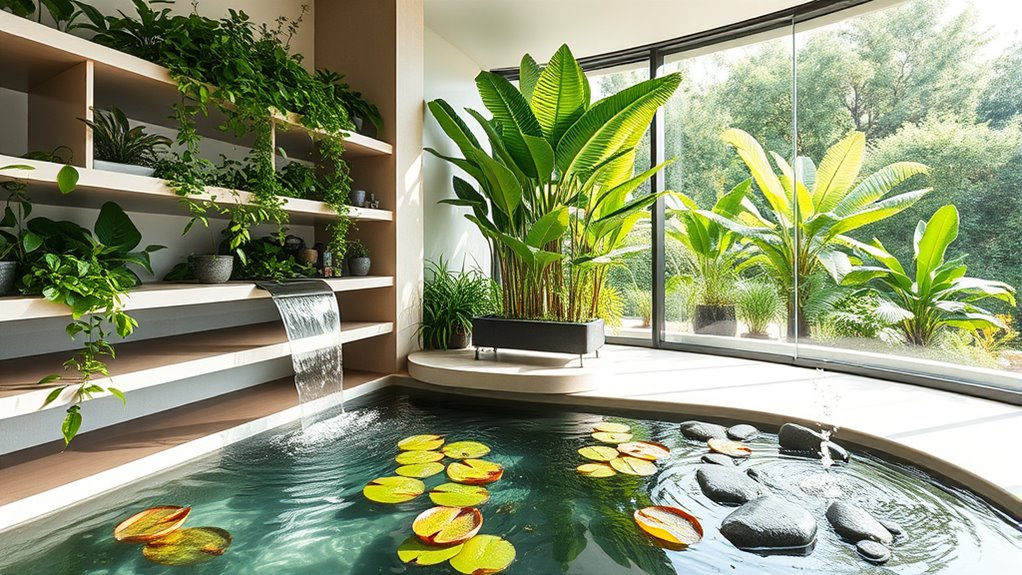
Adding water elements can instantly create a sense of calm in your space. You might incorporate soothing water sounds, visual water features, or aquatic plants to enhance relaxation. These elements help you connect with nature and promote tranquility throughout your environment. Incorporating energy-efficient technology such as water features powered by sustainable systems can also improve your space’s eco-friendliness and reduce operational costs.
Soothing Water Sounds
Incorporating the gentle sounds of flowing water can substantially enhance a space’s sense of calm and tranquility. Soothing water sounds create a calming ambiance, helping you focus and reduce stress during work. You can achieve this with small indoor fountains, water bowls, or even sound machines that mimic natural streams. These elements mask background noise and promote relaxation. Consider the following options:
| Water Element | Best Use Case |
|---|---|
| Indoor Fountain | Central feature for continuous sound |
| Water Sound Machine | Adjustable volume for personalized calm |
| Tabletop Water Bowl | Compact, ideal for limited space |
Additionally, choosing water features that align with Biophilic Design Principles can further enhance your home office’s natural appeal.
Visual Water Features
Did you know that visual water features can substantially enhance a space’s sense of calm? Incorporating water wall installations or an indoor fountain placement creates a soothing focal point in your home office. These features introduce movement and a gentle visual rhythm, naturally drawing your attention and reducing stress. Position your water wall where it’s easily visible from your desk, allowing you to enjoy the calming flow without distraction. An indoor fountain can serve as a centerpiece, adding depth and tranquility to your environment. The visual presence of water, combined with its soft reflections and flowing motion, helps promote relaxation and mental clarity. Thoughtfully integrating these elements supports a peaceful work atmosphere, making your office a sanctuary of calm and focus. Additionally, selecting water features that incorporate protective styling benefits can help maintain your space’s durability and aesthetic appeal over time.
Incorporating Aquatic Plants
Since aquatic plants naturally thrive in water environments, placing them in your space can enhance its calming atmosphere. You can choose from various aquatic plant varieties like peace lilies, water hyacinths, or floating ferns to add greenery and tranquility. These plants not only improve water quality but also create a soothing visual element. To keep your aquatic plants healthy, regular water feature maintenance is essential, including proper cleaning and monitoring water levels. Incorporating aquatic plants into your home office can reduce stress and boost focus, making your workspace more inviting. Remember to select plants suited for your water feature size and conditions, ensuring they thrive and continue to contribute to your biophilic design.
Embracing Earth Tones and Organic Colors
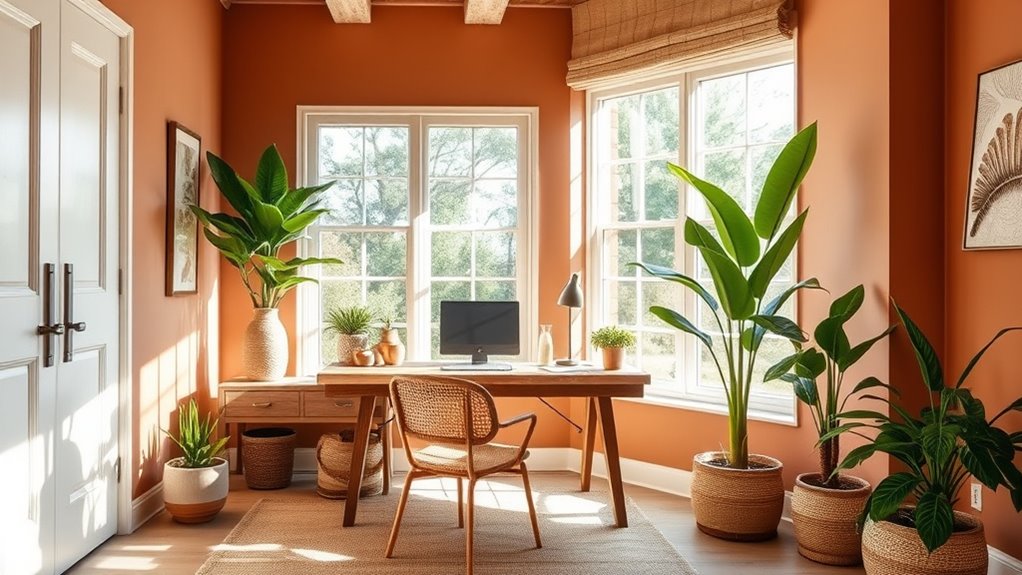
Embracing earth tones and organic colors can transform a space into a calming, natural sanctuary that aligns with biophilic design principles. By choosing earthy hues and nature-inspired palettes, you create an environment that feels grounded and soothing. To evoke emotion and connection, consider these elements:
- Use warm browns and soft greens to foster comfort and stability.
- Incorporate muted terracotta and gentle taupe for a sense of warmth and coziness.
- Combine subtle beiges and natural greys to promote focus and clarity.
These colors evoke the essence of nature, helping you feel more relaxed and centered during work. When you incorporate these palettes, your home office becomes a place where nature’s calmness enhances productivity and well-being effortlessly.
Designing for Visual and Physical Connectivity With Nature
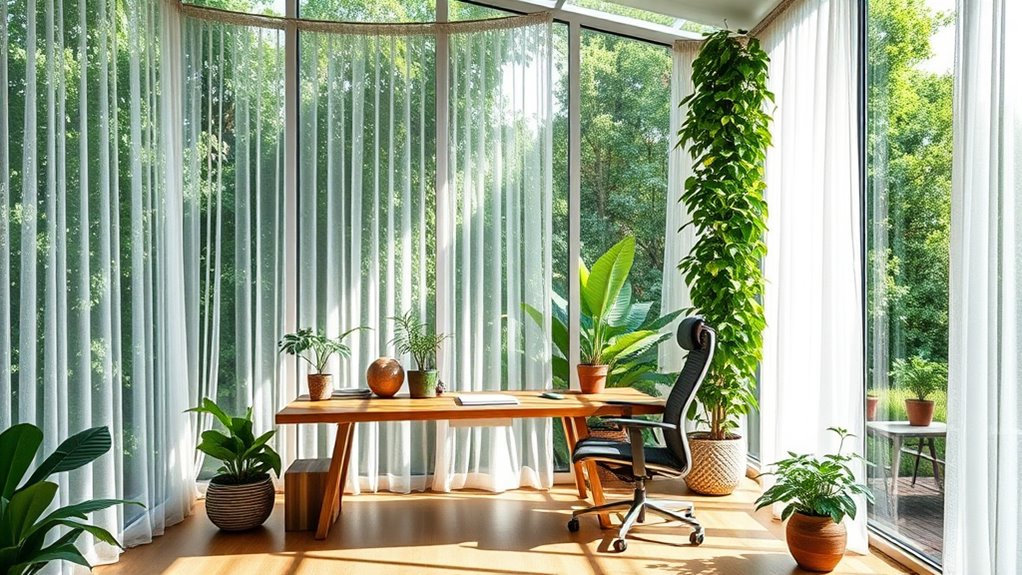
Building on the calming effects of earth tones and organic colors, designing for visual and physical connectivity with nature enhances your space’s restorative qualities. Maximize natural lighting by positioning your desk near windows, reducing the need for artificial light and boosting mood. Incorporate views of greenery through large windows or glass doors to create a seamless connection with outdoors. Use ergonomic furniture that encourages movement and comfort, supporting your physical connection to your environment. Consider this table to optimize your design:
| Element | Tip | Benefit |
|---|---|---|
| Natural Lighting | Place work areas near windows | Improves mood and focus |
| Views of Nature | Install large windows or glass walls | Reduces stress and enhances well-being |
| Indoor Plants | Add greenery to your workspace | Boosts air quality and aesthetics |
| Ergonomic Furniture | Choose adjustable chairs and desks | Promotes comfort and movement |
Maintaining a Clutter-Free and Organized Environment
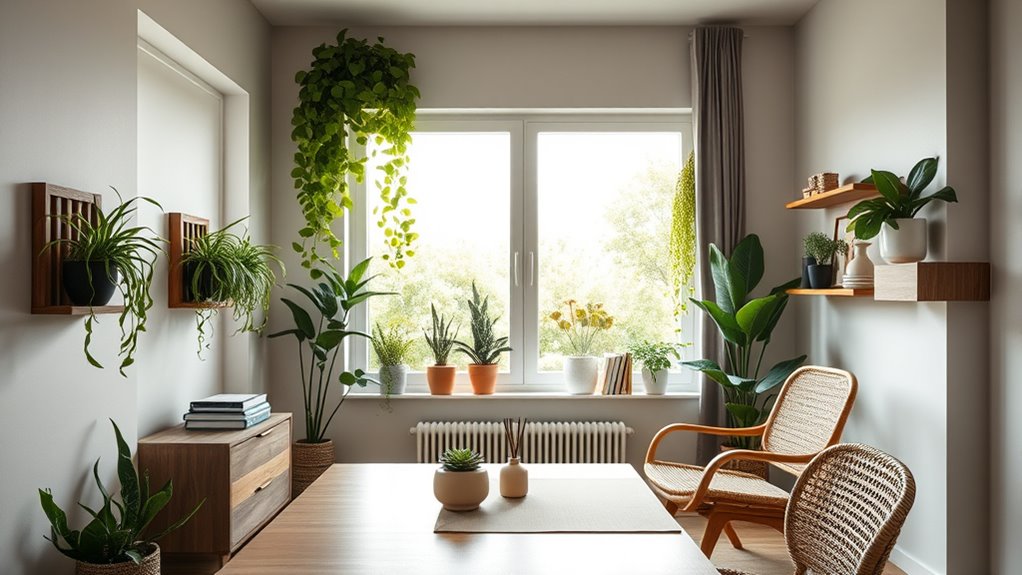
Maintaining a clutter-free and organized environment is essential for enhancing focus and reducing stress in your space. When your workspace is tidy, you create a calming atmosphere that promotes productivity and creativity. To achieve this, consider these decluttering techniques:
- Regularly review and discard unnecessary items to prevent buildup.
- Use effective storage solutions like shelves, drawers, and labeled containers to keep essentials accessible.
- Establish daily routines to tidy your workspace, ensuring clutter doesn’t accumulate.
These steps help you stay in control of your environment, making it easier to focus on your work and connect with nature through your biophilic design. An organized space not only boosts efficiency but also nurtures your well-being, creating a harmonious balance between work and nature.
Frequently Asked Questions
How Can Biophilic Design Improve Productivity and Mental Well-Being at Home?
You can boost productivity and mental well-being at home by strengthening your connection with nature and reducing stress. Incorporate natural elements like plants, natural light, and earthy colors to create a calming environment. These features help you feel more relaxed and focused, making work easier. When you bring nature indoors, you’ll notice improved mood and better stress management, leading to a healthier, more productive home workspace.
What Are Cost-Effective Ways to Incorporate Biophilic Elements Into Home Offices?
You can incorporate biophilic elements into your home office cost-effectively by adding greenery like low-maintenance plants or succulents. Use DIY natural features such as homemade planters or natural wood accents to bring in organic textures. Rearrange your space to maximize natural light and include windows with views of nature if possible. These simple, budget-friendly steps help improve your environment, boosting productivity and mental well-being without breaking the bank.
How Does Biophilic Design Influence Air Quality and Overall Health?
Imagine stepping into a Victorian greenhouse—your home office can be just as revitalizing. Biophilic design improves indoor air by promoting natural ventilation and increasing fresh air flow. This reduces indoor pollutants, boosts oxygen levels, and enhances overall health. Better air quality lowers stress and fatigue, helping you stay focused. By integrating plants and natural light, you create a healthier space that supports your well-being and productivity every day.
Can Biophilic Principles Be Adapted for Small or Shared Home Office Spaces?
You can definitely adapt biophilic principles for small or shared home offices. Incorporate vertical gardens to maximize greenery without taking up much space, and guarantee natural lighting floods the area to boost mood and productivity. Use plants at different levels, and position your workspace near windows. These strategies create a calming, healthy environment, making your small or shared office feel more connected to nature and improving your overall well-being.
What Maintenance Is Required to Sustain Biophilic Features Long-Term?
Imagine your home office as a lush garden thriving with life. To sustain biophilic features long-term, you need to regularly care for your plants, ensuring they’re watered and pruned. Use sustainable materials for any updates or replacements, reducing environmental impact. Maintaining a healthy, vibrant space requires consistent attention, but your effort keeps the natural beauty alive, making your workspace a calming, energizing haven that thrives with your care.
Conclusion
By incorporating indoor plants, maximizing natural light, using natural materials, creating views of nature, integrating water elements, embracing earth tones, designing for connectivity, and maintaining organization, you create a harmonious, inspiring, and calming home office environment. These principles work together to enhance your well-being, boost your focus, and foster creativity. When you prioritize these elements, you transform your workspace into a sanctuary that nurtures both productivity and peace, making every workday a more fulfilling experience.
